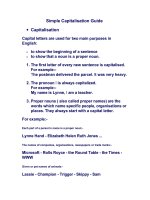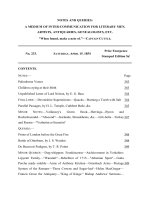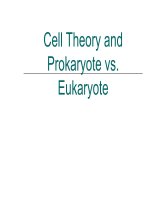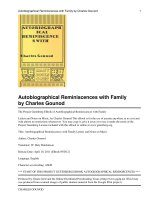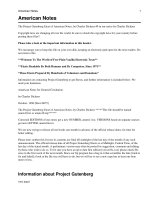- Trang chủ >>
- Đề thi >>
- THPT Quốc Gia
s1004 notes
Bạn đang xem bản rút gọn của tài liệu. Xem và tải ngay bản đầy đủ của tài liệu tại đây (231.24 KB, 3 trang )
STUDY NOTES
EPISODE 4: RISING DOLLAR
MAKING COMPARISONS
STUDY TIPS
When describing information presented in
graphs, tables or pie charts, it is necessary
to use language specifying amount, and the
language of comparison.
In IELTS Writing task 1, it is
important to make factual
statements, about the data in
graphs, tables or pie charts.
In specifying amount the use of per cent
and percentage is important because visual
data is commonly presented in this form.
Statements describing trends in
must be supported by examples,
and taken from the information
supplied in the IELTS question.
Of equal importance is the use of
comparative language, making the
description of the visual data meaningful,
and meeting the requirements of the IELTS
Writing task.
When describing data use a variety
of structures, including both ‘per
cent’ and ‘percentage’, and
comparative language.
Language specifying amount
The two words, per cent and percentage, are commonly used when specifying
factual information in graphs, tables or pie charts. These words, however, are often
confused or misused. The differences in meaning and use are as follows.
PER CENT /p 's nt/ - (two words) British English, Australian English
PERCENT /p 's nt/ - (one word) American English, Canadian English
specifies an amount for or in every hundred
can be used as a noun, adjective or adverb
in formal writing, use per cent (percent), rather than the % sign
use per cent (percent) with a number, for example:
It is predicted that house prices will rise 2 percent over the year.
PERCENTAGE - (one word only)
/p 's nt / - British English, Australian English
/p 's nt
/ - American English, Canadian English
specifies an amount for or in every hundred; this is not the same as a total
number
used as a noun
percentage can be followed by either a singular or plural noun, for example:
A small percentage of the state’s budget is used for infrastructure.
A large percentage of the buildings in that street will be demolished.
Page 1 of 3
Language of comparison
When describing trends in graphs, table or pie charts, it is necessary to select and
compare salient features or meaningful items. There are a number of ways
comparisons can be made.
Adjectives have three degrees of comparison:
positive
comparative
superlative
big, good, interesting
bigger, better, more interesting
biggest, best, most interesting
Comparative
comparative forms are used to compare 2 people, places, things, and actions:
Taking the train is faster but more expensive than driving to Sydney.
If the second person, place, thing or action is given, then ‘than’ is added after
the comparative.
Superlative
superlative forms are used to compare 3 or more people, places, and things:
Walking is the cheapest and the best form of exercise.
‘the’ is always used with superlatives
Page 2 of 3
Comparative and Superlative forms of adjectives
One-syllable adjectives
Add -er and -est to the positive adjective to form the comparative and
superlative degrees:
hard
large
harder
larger
hardest
largest
Some adjectives have irregular forms:
good
bad
better
worse
best
worst
Some adjectives have more than one form:
far
Spelling tip:
farther/further
farthest/furthest
If an adjective ends in a single consonant and is preceded by a
single vowel, the consonant is doubled
thin
big
thinner
bigger
thinnest
biggest
Two-syllable adjectives
Use more/less and the most/the least to form the comparative and
superlative degrees:
modern
profitable
more/less modern
more/less profitable
the most/the least modern
the most/the least profitable
If an adjective ends in a final –y and is preceded by a consonant, the –y
changes to an –i before –er and –est:
Easy
Funny
Spelling tip:
easier
funnier
easiest
funniest
If an adjective ends in an –e, the final –e is dropped before –er
and –est:
simple
secure
simpler
securer
simplest
securest
Page 3 of 3
